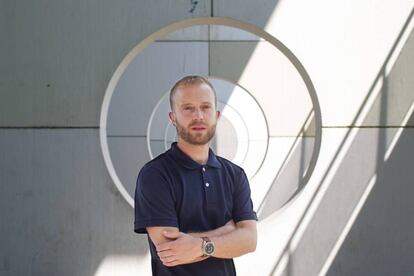Spaniard held for 40 days in US prison over 2011 vacation to Syria
Leandro Pérez Cadarso falls victim to tough new migration rules on travel to some Muslim countries

A 32-year-old Spanish architect who found himself the victim of US President Donald Trump’s tough new entry policies spent 40 days in a US jail and was then deported after it was noted on a visa application that he had traveled to Syria on vacation six years ago.

Leandro Pérez Cadarso, who moved to Mexico four years ago in search of work, was arrested as he tried to cross the border into the United States at Tijuana on April 23. He was not charged and no explanation was given as he was manacled, taken away and held in jails in San Diego and Calexico.
Finally, after more than a month, he was deported, arriving in Madrid two weeks ago. He will now not be able to apply for a visa to the United States for five years.
“I’ve been through some frightening moments,” says Pérez. “I didn’t understand what was going on. I hadn’t done anything wrong. Nobody told me anything. I thought that some criminal had the same name as me or that somebody had put drugs in my backpack,” he adds.
I thought that somebody had put drugs in my backpack Leandro Pérez Cardoso
Pérez says that at the crossing into the United States at Tijuana, he told an immigration official that he had a valid entry visa from a previous visit to Los Angeles, but that when he renewed his passport during a recent visit to Spain, he had applied for another visa to include it in his new passport. That visa had been denied because he had ticked a box saying he had traveled to Syria.
The 32-year-old says he visited Syria in 2011 on a trip with his parents, sister and an aunt, taking in ancient monuments, among them the Roman ruins at Palmyra – parts of which have now been destroyed by the so-called Islamic State (ISIS).
The customs official typed in his details, which is when his nightmare began. “He looked at me in a strange way and asked me to go into a room. He didn’t speak Spanish,” explains Pérez. Two police officers then put him up against the wall and handcuffed him from behind. “I was very frightened and told them I had done nothing wrong and that if I couldn’t enter the United States they could let me return to Mexico.”
Nobody from the Spanish consulate visited Pérez during his ordeal
He was then taken to a detention center in San Diego and put in a holding cell with 30 other men for three days, unable to sleep.
He had been allowed a phone call on the day of his arrest and had contacted his girlfriend, who told his family. Pérez’s father then contacted the Spanish consulate in Los Angeles, which phoned Pérez. But nobody from the consulate paid him a visit, and officials said they could do nothing as the matter was in the hands of the US Customs and Border Protection service. A French citizen arrested earlier this year because he had visited Iran was reportedly visited by consulate officials and informed of his situation.
On April 27, Pérez was transferred to Calexico, which houses 700 prisoners, where he was held until his deportation. During his time there he says he helped the mainly Hispanic prison population fill in forms in English. He says he was he ever asked about his trip to Syria.
Pérez says he now intends to study an MBA in Business Management and hopes to find work in Spain as an architect after his experience in several firms in Mexico.
English version by Nick Lyne.
Tu suscripción se está usando en otro dispositivo
¿Quieres añadir otro usuario a tu suscripción?
Si continúas leyendo en este dispositivo, no se podrá leer en el otro.
FlechaTu suscripción se está usando en otro dispositivo y solo puedes acceder a EL PAÍS desde un dispositivo a la vez.
Si quieres compartir tu cuenta, cambia tu suscripción a la modalidad Premium, así podrás añadir otro usuario. Cada uno accederá con su propia cuenta de email, lo que os permitirá personalizar vuestra experiencia en EL PAÍS.
¿Tienes una suscripción de empresa? Accede aquí para contratar más cuentas.
En el caso de no saber quién está usando tu cuenta, te recomendamos cambiar tu contraseña aquí.
Si decides continuar compartiendo tu cuenta, este mensaje se mostrará en tu dispositivo y en el de la otra persona que está usando tu cuenta de forma indefinida, afectando a tu experiencia de lectura. Puedes consultar aquí los términos y condiciones de la suscripción digital.
More information

Defiant Mexico slams Trump over new migration proposals
Archived In
Últimas noticias
Half of Scotland is in the hands of 420 property owners
Pinochet’s victims grapple with José Antonio Kast’s rise in Chile
Reinhard Genzel, Nobel laureate in physics: ‘One-minute videos will never give you the truth’
From digital curfews to blocking apps: How technology experts protect their children online
Most viewed
- Pablo Escobar’s hippos: A serious environmental problem, 40 years on
- Reinhard Genzel, Nobel laureate in physics: ‘One-minute videos will never give you the truth’
- Why we lost the habit of sleeping in two segments and how that changed our sense of time
- Charles Dubouloz, mountaineering star, retires at 36 with a farewell tour inspired by Walter Bonatti
- The Florida Keys tourist paradise is besieged by immigration agents: ‘We’ve never seen anything like this’









































